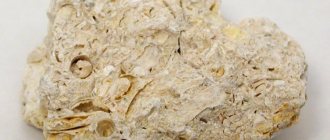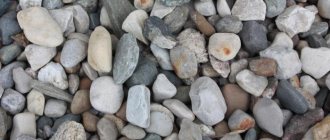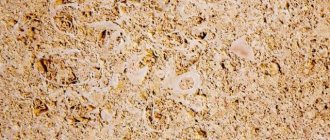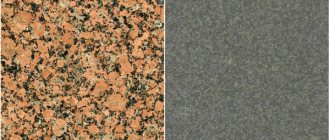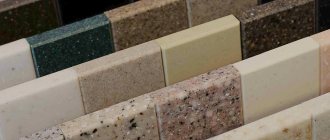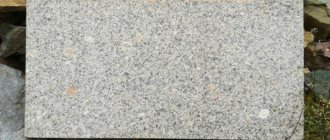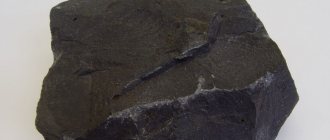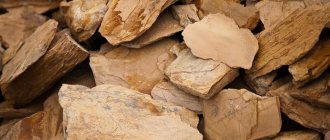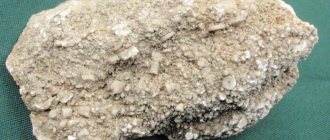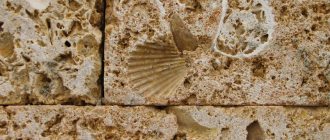December 10, 2015 Tiles, marble, granite, stone
To understand what limestone is, you need to know about its origin and locations. Looking ahead, let's say that this rock is in great demand in construction as a natural stone, and also as a binding element in the production of lime and cement.
Limestone is also used in the food and chemical industries and as a flux (impurity) in metallurgy. Such widespread use and popularity of the material explains its extraction on a huge scale in many parts of the world.
The concept of limestone, its chemical formula, what it looks like in the photo
Limestone is a sedimentary mineral of organic or chemogenic origin. It is characterized by a maximum content of calcium carbonate (CaCO3), which is presented in the form of calcite crystals of different sizes. If you examine the material at high magnification under a microscope, you can find impurities of phosphates, silicon, sand and clay particles, and the remains of shells of ancient microorganisms. The chemical formula of limestone, which contains dolomite, is CaMg(CO3)2. The admixture makes the material strong and dense.
The photo shows that the mineral can look different. The rock composed of shells (shell rock) has a fine-grained structure, while its relative chalk has a fine-grained structure. Chalk, marble, stones with inclusions of round shells (nummulitic limestones) are all varieties of limestone. What color is the mineral? The picture shows that it is naturally white. Impurities and their combinations give the mineral unique shades.
Where to buy stone and order processing services?
The modern stone processing industry offers quality solutions for your needs. Master Group Company LLC carries out direct supplies of limestone from mining companies and offers processing services at its own industrial complex. We provide high quality products, carry out all the necessary stages of production for the long service life of finished products. The work is done on a turnkey basis. For questions about ordering services or for detailed consultations on the purchase and processing of stone, call the company's managers.
Characteristics and origin of calcareous mineral
Natural stone limestone is a non-solid sedimentary rock with a maximum content of calcite. The rest of the mineral mass consists of inclusions of particles of other substances (silicon, phosphates, quartz, lime, etc.). Microparticles of the skeletons of simple organisms can also be found in the mass of calcium carbonate. The origin is generally characterized as organic, but there is also an organo-chemical path to the formation of the mineral.
The limestone mineral is mainly formed in the shallow water environment of the sea basin.
Freshwater conditions also allow limestone to be deposited. Its usual form of occurrence is a layer. It can be deposited according to the principle of salt: during the evaporation of water from lakes and lagoons. But the bulk of the stone originated precisely in the depths of the sea, where there were no intense processes of evaporation and drying.
The natural mechanism of mineral formation begins with the work of living organisms. They extract calcite from seawater and build shells. Then the remains of their skeletons accumulate on the bottom surface in a huge mass. The most significant example of the formation of calcite carbonate is the birth, growth and death of coral reefs. It is not uncommon for piece shells to be found on a fracture in a calcareous rock. This variety is called shell rock.
Other species are also named according to the types of organisms and their metabolic products:
- nummulitic;
- bryozoan;
- oolitic.
Marble-like limestone is a separate category. It, in turn, is divided into massively layered and thin-layered types. Under the influence of certain temperatures and pressure, it changes the structure of the crystals and is transformed into marble.
Zodiac signs
Limestone, the basis of which is calcite, can be recommended to all zodiac signs except Scorpios. Representatives of this zodiac sign are most prone to black magic and the occult, while the energy of the stone is light. That is why strong-willed Scorpios do not find a common language with him.
The rest of the signs of the Zodiac circle can fully experience the positive properties of limestone. Representatives of the astral house, who need clarity and accuracy in their professional activities, will especially feel the help of the stone. These are financiers, accountants, doctors and representatives of legal structures. Back to contents
History and origin of the breed
Limestone was used in ancient times. The Greeks built temples of the gods from it. In Egypt, the pyramid of Cheops was laid out with hewn monoliths. In Russia and Malta, buildings and cathedrals were erected from it. Archaeologists have found many stone figurines, stucco moldings, and interior items.
Limestone requires sedimentary rock to form. It appears in two ways. In the first case, this is the precipitation of substances from hot solutions, for example near thermal springs. Petrification occurs during the cooling process.
In the second option, the remains of fish skeletons, mollusk shells, and other organic elements settle to the bottom. The thickness of the water contributes to their compaction and subsequent hardening.
This sedimentary rock is also called rock. The explanation is simple: subsidence occurs over a long period of time over a large area. The result is massive strata containing various fossilized minerals. Sediments change the bottom topography, forming hills. After the ancient seas dried up, mountains with sedimentary rocks were left on the earth, where limestone was first found.
Well-known “relatives” of the mineral are marble and soda ash.
The first is formed during the process of metamorphosis, which caused the recrystallization of limestone. The second deposit contains sodium
Carbonate rock deposits
Work on the preparation and development of deposits is carried out in the following sequence:
- clearing the territory of the top fertile layer with its subsequent storage for the purpose of land reclamation;
- moving the clay layer using electric excavators;
- sampling of substandard raw materials;
- clearing access to limestone;
- carrying out blasting operations;
- loading of raw materials;
- cleaning the area and transporting waste to dumps.
The solid layer of limestone that was not exposed to the explosion is drilled and explosive materials are laid for re-work. For drilling, electric installations are used that make it possible to make a hole in the rock to a depth of 24 m and a diameter of 16 mm.
The distance between the wells stretched in a line is 5 m. TNT is used as detonators. For one explosion, about 30 holes are drilled.
The carbonate compound is not uncommon, and deposits can be found throughout the world. Limestone is extracted using open-pit (quarry) methods.
Work related to the exploitation of the deposit requires compliance with safety precautions with explosives. It is necessary to adhere to regulated standards for performing loading and unloading operations and forming dumps.
Limestone deposits in Russia are located in almost every corner of the country (Voronezh, Arkhangelsk, Belgorod, Vologda regions, Siberia).
Carbonate deposits in the Russian Federation are located in various cities, and the Krasnodar Territory is no exception. In coastal areas, raw materials are extracted that are characterized by high strength and a variety of textures.
The development of deposits is closely related to the needs of production and construction. It is not economically profitable to transport the extracted material over long distances, so quarries are usually located near industrial facilities involved in the processing of ore raw materials, construction, and cement production.
Deposits where limestone is mined are often bordered by layers of clay or sand. But the presence of small cracks in the bedrock helps speed up the process of extracting material.
How is it formed in nature, where is it mined?
The limestone rock appears in the seas from the shells of mollusks, algae, corals and other inhabitants of sea waters. To build shells, some sea inhabitants require calcite, the source of which is water. The remains of tiny creatures accumulate at the bottom and are cemented under water pressure. They can be held together and saturated with minerals by solutions and gas streams that seep through the bottom.
Freshwater conditions also allow rock to be deposited. It can be deposited as lakes and lagoons evaporate. A separate category is marble-like limestone, which under the influence of temperatures and high pressure becomes hard and dense.
The usual form of rock occurrence is a layer. The method of its extraction depends on the location, age and type of limestone. It is extracted in an open way, after preliminary development of the quarry. To do this, the top layer of soil and clay is removed, then pyrotechnic work is carried out, which makes it possible to crush limestone and detach portions of stone. Next, the material is loaded into machines and taken out for processing.
Initially, when mining, people used the breaking method - the material was removed with crowbars and the layers were knocked out using hammers. An alternative to the method is blasting, as a result of which the rock is crushed into crumbs. Using an excavator, it is collected, loaded into dump trucks and transported to factories for processing.
Currently, it is possible to do without an explosion, for which, instead of an excavator bucket, an attachment is used that loosens the rock. The most profitable way to extract limestone is with a milling machine. At the same time, it mines, crushes and transports limestone from the mine to the processing plant.
Limestone mining
In Russia, the mineral is mined and developed primarily through drilling and blasting (D&B). Stripping work is carried out in advance - the top layer of soil is removed using a bulldozer and subsequently used for reclamation. Shafts up to 24 meters deep are drilled into a solid layer of limestone, and industrial explosive materials and detonators (TNT blocks) are placed in them. One explosion usually requires 2-3 dozen wells and about 5 tons of explosives. The wells do not explode simultaneously, but with a delay of a fraction of a second.
There is an alternative European technology for limestone mining called Rip&Load (loosening and loading), which allows you to work without the use of drilling and blasting equipment. The face mass is destroyed using a special ripper on a heavy excavator, after which the operator, without leaving the cab, changes the ripper to a bucket and loads the destroyed rock mass into a dump truck. Then the operation is repeated. The advantage of this technology is the selective excavation of limestone in deposits with a layered structure. In both cases, heavy industrial equipment is used. For example, the operating weight of excavators in quarries can reach 240 tons, and their productivity can be 800 t/h.
The resulting rock fragments are loaded by a heavy excavator into mining dump trucks and transported to the crushing and processing plant (COP). As a result, the quarry bowl moves towards the calcareous rocks, and the mined-out space is gradually filled with screenings and overburden.
At the crushing and processing plant, limestone is successively subjected to coarse, medium and fine crushing. Small particles of stone (up to 1 cm) are transported back to the quarry. The finished product (crushed stone) is loaded into railway cars or vehicles and sent to consumers. In places with small deposits, limestone is simply sawed into rectangles of the required size and transported by truck to the plant.
In Russia, the main deposits of the mineral are located in the Moscow and Tula regions. In Tula (in addition to the usual) valuable marbled limestone is mined, in the Moscow region - a rare cream-colored rock. Limestone is found in almost every region of the Earth, and some quarries have been in use for thousands of years.
What substance is the basis of limestone?
The basis of limestone is the same substance - calcium carbonate (formula: CaCO3). This means that, despite the abundance of forms and variations, all limestones have much in common. First of all, it is the ability to gradually dissolve in water and acids, the tendency to get wet when exposed to moisture, hygroscopicity, and relative softness, making it easy to process.
When heated, limestone decomposes into calcium oxide (CaO) and carbon dioxide (CO2). The decomposition reaction of limestone is used in the production of lime. Another distinctive feature of this material is the biological origin of most of its mass, the presence of imprints of mollusks and other living creatures, whose sediments became part of it
The oldest deposits are hundreds of millions of years old. The main place of its formation and accumulation was the bottoms of seas and reservoirs.
This rock is also interesting because under the influence of water, underground voids and caves are formed in it, many of which have become recreational sites. The caves were actively used by ancient people.
Types of formations
Chemogenic formations (rocks formed without the participation of biological processes) are divided into types depending on the structure of the rock and the grain size of the carbonate clastic material and determine the nature of the rock formation and the origin of the limestone.
Micrograined rock is the result of the vital activity of microorganisms and is a product of their processing of calcium nitrate into a carbonate compound.
White limestone, which is a mass of micro-grained carbonate material, is not usually composed entirely of chemogenic sediment. As a detailed study of writing chalk under a microscope shows, the microgranular part of the calcium carbonate compound (limestone formula CaCO3) contains the remains of the skeletons of microscopic coccolithophorid organisms.
The second type of formations is represented by calcareous crusts and characteristic inlays. The sediments formed directly on the bottom of the sedimentary basin, evenly distributed over the fossilized sediment.
White limestone, which is a mass of micro-grained carbonate material, is not usually composed entirely of chemogenic sediment
Favorable formation conditions at the bottom of shallow areas could be suitable for the direct release of calcium carbonate and characterized by an increased temperature gradient.
Among the hemogenic formations other than coral reefs are concentric oolites, which form a special type of sediment. The cores of the formations contain carbonate or other sandstones and foraminifera.
The recrystallization of sediment that occurs in reef limestones is associated with coarsening mineral encrustations under conditions of additional sedimentation in the upper parts of the silt.
The process can be facilitated by shallowing conditions if they lead to an increase in water temperature and an upward change in the level of the neutral environment. The degree of crystallization distinguishes or brings together successively changing layers of limestone sediments.
Complete recrystallization of sediments with the destruction of the cemented material completely erases the difference between fragmentary material and cement. An example of this type of deposit is marbled limestone.
The uneven development of crystallization processes in the rock determines the coarse-grained structure of sediments.
Technical Parameters of Limestone
Dolomites and limestones containing magnesium carbonate have greater hardness. They are more difficult to mechanically influence.
Natural limestone is durable and hard. When crushed, it forms an uneven fracture. Doesn't get wet in water. The physical properties of the rock allow it to be used in construction.
Usually the carbonate compound is white, gray in color. But depending on the presence of impurities, the external color and technical characteristics of limestone change. The minerals contained in the formation not only change color, but also affect strength, stability and determine the scope of application.
The carbonaceous substance colors the rock black, the yellow color is determined by the presence of iron hydroxides, and the greenish color is determined by glauconite.
A description of the technical parameters of the material is contained in the deposit passport. The information collected in the document fully reflects the properties of the breed and its compliance with state standards regulated by law.
The structure of limestone allows us to distinguish types of rock. The texture of the mineral formation is uniform, sometimes there are pores and cavities (voids).
Classification by breed color
Calcium carbonate in its pure form is a white powder; the color of limestone stone depends only on impurities, therefore, it can be used to determine what limestone consists of and what is included in its composition, except calcite. And by the intensity of the color one can judge the amount of impurities. Various shades of the mineral are given by:
- Manganese, which colors the mineral red or brown.
- Iron - giving it a yellow or brown tint.
- Fossilized seaweed is the reason for the greenish color of limestone.
- Occasional inclusions of organic matter will make the stone black or dark gray.
A white or light gray color indicates that the mineral either does not contain impurities or their amount is negligible.
Separation according to the structural features of the mineral
The type and amount of impurities determines what limestone looks like, what its structure is, as well as the physical and chemical properties of the stone. In particular, such a parameter as the solubility of the stone under the influence of water and carbonic acid is important, since it determines the ability to resist corrosion. Based on density, solubility and structural characteristics, rocks are distinguished:
- Dolomite - containing magnesium oxide and being a transitional form between limestone and dolomite. Dolomite limestone is characterized by pronounced layering, it is less soluble than other types of mineral, and therefore is less susceptible to corrosion.
- Marble - with a high percentage of carbonate and organic matter. They have high strength, resistance to aggressive factors and a dense fine-grained structure. They are similar in appearance and properties to marble, but are softer because they have not undergone the crystallization process.
- Coral is a porous, easily destroyed rock.
- Clay - soft, friable and brittle, susceptible to corrosion.
Where is limestone used?
The breed is distinguished by its variety of uses in various fields:
- Construction
- Cement.
- Road.
- Metallurgical.
- Agricultural.
- Food.
- Glass
- Pulp and paper.
- Tanning.
- Paint and varnish and others.
Crushed limestone is used in road construction
The material is used in different forms:
- in the form of crushed stone;
- rubble stone, piece or lump;
- mineral powder or crumbs;
- sand;
- facing slabs;
- limestone flour;
- mineral wool.
In hydraulic structures, porous limestone is used as a water filter. This breed is in great demand when arranging the foundations of buildings. The components of ordinary limestone are lime and concrete.
Crushed stone is part of the road surface of routes that are not subject to frequent loads. Limestone is used to produce soda and is also the basis of numerous mineral fertilizers.
Limestone is good at splitting, cutting and sawing, and can be processed in any direction. The high thermal insulation properties of the rock and its durability make it possible to create a wide variety of high-quality building materials.
Impact of climatic conditions on the properties of limestone
Rock is valued as a building material for its low density, pliability to sawing and cutting tools, excellent adhesive properties and a variety of external advantages.
Humid climatic conditions significantly reduce the strength of limestone. Moreover, the stone is characterized by the heterogeneity of the rock, therefore the density here is different. Special attention must be paid to this important point.
The strength of the material and the duration of its operation are affected by its frost resistance. This parameter is much higher in crystalline limestones, but in the absence of pores and cracks in the material.
To prevent the destruction of the natural material during its use, it is necessary to take into account the above-mentioned properties of limestone.
Physical properties
The choice in favor of limestone is justified by its unique thermal insulation properties: it is able to maintain optimal temperature even on the hottest summer days and cold autumn nights. The astringent properties of limestone, which were used in the construction of walls and towers, are widely known. Limestone is fired to produce quicklime, which is indispensable in the production of mortar and concrete.
Due to its low strength, limestones are easily susceptible to weathering processes. Thus, when arriving at the Divnogorye Museum-Reserve in the Voronezh Region, you can see a system of ravines developing along limestones that are unstable to water and wind. By the way, on the territory of Divnogorye there is also the famous Church of the Sicilian Mother of God, located right inside the limestone mountain and is in many ways a symbol of the entire museum-reserve.
What are formations characterized by?
Among carbonate deposits, the following types of limestone are distinguished:
- dense carbonates (characterized by a homogeneous structure);
- oolitic formations of spherical shape;
- tuffs are formations with large pores, which are durable and easy to process (polished, grinded);
- travertine – sinter formations;
- clayey and bituminous limestones.
The coral limestone in the sediments is supplemented with an admixture of foraminiferal shells and mollusks, and echinoderm shells. The rock that makes up modern reefs has a hard, porous structure and consists of the skeletons of colonies of polyps.
Putilov limestone is known as the main building material used during the construction of the city of St. Petersburg. The name of the rock is associated with the Putilov deposit located nearby.
The density of limestone is average, it does not collapse under the influence of shock loads, and is resistant to abrasion, aggressive acidic environments and salts. It contains small voids formed as a result of rock leaching.
The color of limestone is gray, alternating with dark gray. The crystalline mineral formation of organogenic origin contains dolomite (2-25%), glauconite grains (up to 20%), phosphates (2-3%), grains of silicate compounds (quartz).
Due to its external similarity, limestone is often mistaken for marble. The difference between breeds lies in the form of their formation. For example, the black Portoro marble from which sculptures are created is a sedimentary rock. The structure of limestone is different from marble.
The formation of marble occurs through the process of metamorphic changes and recrystallization of rock. It contains no traces of fossils.
If the conversion process is not completed, the result is marbled limestone. It is this rock that contains white calcite inclusions of bioherms (corals), shells, and fragments of skeletons of other marine inhabitants.
The petrographic and mineralogical definition of the rock is “marble-like limestone.” In the literature on engineering geology, in the section devoted to the classification of rock types, incompletely transformed limestone is called marble.
Dolomitized limestone is a gray and dark gray sedimentary rock composed of calcite and dolomite. The mineral composition of the formations is formed by inclusions of gypsum, anhydrite and silicon, feldspars, pyrite, clayey matter and flora relics (blue algae).
The strength of limestone, which includes magnesium carbonate (about 40%), during compression is 400-1300 kgf/cm², the hardness of dolomite on the Mohs scale is 3.5-4.5.
Limestone composition
The chemical composition of pure limestones is close to calcite, where CaO is 56% and CO2 is 44%. Limestone in some cases includes admixtures of clay minerals, dolomite, quartz, less often gypsum, pyrite and organic residues, which determine the name of limestone. Dolomitized limestone contains from 4 to 17% MgO, marly limestone - from 6 to 21% SiO2 + R2O3. The sandy and silicified limestone contains admixtures of quartz, opal and chalcedony. It is customary to reflect in the name of limestone the predominant presence of organogenic remains (bryozoan, algal), or its structure (crystalline, clotty, detritus), or the shape of rock-forming particles (oolitic, brecciform).
Types of limestone
Natural stone is characterized by the following parameters:
- origin;
- structure;
- chemical composition;
- structure.
Video: Limestone-shell rock
Origin of the stone
- Organogenic. They are formed from various remains of organic origin, which include: slurry and reef limestone, as well as shell rock.
- Chemogenic. Occur during calcium precipitation.
- Clastic. They are the result of the destructive activity of the oldest limestones.
Limestone structure
- Dense. They are found in almost all formations. For the most part they consist of fragments of shells or shells of various microorganisms and a small part of the smallest grains.
- Microcrystalline or marble-like limestones are subtypes of marble.
- Earthy limestones are chalk.
- Porous. This is the structure of travertine, calcareous tuff, and shell rock.
Chemical composition
- Dolomitized. These limestones contain up to 17% magnesium. As this figure increases, dolomitized limestones pass into the dolomite group, having previously gone through a number of intermediate processes.
- Marbled limestones are transitional variants of formations that result in transformation into marble.
- Marls. Stones containing up to 50% clay particles.
Structure
- Limestones differ in degree of grain size:
- Oolitic. They have a granular structure. The oolite grains are tightly bound together. The grain size does not exceed 1 mm. Oolites have the ability to dissolve. Then voids form in their place.
- Posolite. The structure of these limestones consists of larger grains, the size of which exceeds 1 mm.
Varieties of limestone
All limestones are divided by origin, color, chemical composition, physical properties, structure, and application features.
The most common colors of this breed are:
- White or greyish. Chemically pure limestone rocks, consisting almost exclusively of calcium carbonate, have this color.
- Brown and yellow colors are due to the presence of iron compounds.
- Red, pink and brown limestone is obtained in the presence of an admixture of manganese compounds.
- The green color of this rock is given by the remains of seaweed.
- Dark and black colors are associated with the presence of heavy hydrocarbon fractions in this rock. These types of limestone are very rare.
ORIGIN OF LIMESTONE ROCKS CAN BE BIOGENIC, CHEMOGENIC AND SECONDARY
In the first case (the most common option), the reason for their formation is the accumulation of calcareous shells and other fossils in the thickness of the seabed. In the second - chemical transformations during which calcium carbonate is formed. In the latter case, the formation of new strata is associated with the natural transformation of previously destroyed limestones.
Based on the time of occurrence, Jurassic, Triassic, Cretaceous limestones and other types are distinguished. The name of limestone corresponds to the geological period within which its formation took place. Since natural conditions were different in different eras, the limestones themselves were not the same. The composition of the imprints of ancient organisms also depends on the time of their origin, since different types of living beings predominated in different geological periods.
Limestones are also classified by variety. The following types are common:
- Dolomitized. Contain a significant admixture of magnesium oxide. At its maximum content, dolomites are obtained.
- Coral. They are formed in modern warm seas and form the basis of coral reefs. They have a porous consistency.
- Clayey. Such rocks contain a significant admixture of clay. As it increases, marl is formed.
- Marbled. Relatively dense limestones of light or gray-blue color. May also contain fossils.
Based on their application, limestones are divided into construction (cladding) and fluxing limestones. The former are used in the construction of houses and facing work. The second is in metallurgical production.
Historical uses of limestone
This natural stone has long been used by man in construction and in other areas of his activity. In the past, buildings, temples, cathedrals and other structures and structures were created from limestone. Limestone made the greatest contribution (among other rocks) to the culture, history and life of former Russia. Such well-known expressions as “white stone Moscow”, “white stone chronicle”, “white stone architecture” are associated with it. The reason for their appearance was white limestone mined near the village of Myachkovo in the Moscow region. It was he who went to the construction of buildings and structures in the central zone of the European part of Russia.
The famous Egyptian pyramids were also built from limestone.
Limestone pyramids
After the advent of millennia, they were well preserved, which could be due to the lack of rain, which can cause corrosion of this material. Another example of the use of limestone rocks is the Great Wall of China. Despite the effects of moisture and acid rain, it continues to fulfill its now recreational function, attracting a huge number of visitors every year from around the world.
In Mediterranean countries, limestone is one of the most common rocks. Therefore, many buildings there are constructed based on this material. The state of Malta is especially distinguished in this regard, where almost all buildings are made of limestone. This stone was also actively used in the construction of buildings in ancient Greece and Rome.
Place of Birth
Limestone deposits are common in Leningrad and Vologda regions. Voronezh, Tula regions, the Urals and the northern Caucasus. The largest deposit of limestone and dolomite in Europe is located in Ukraine. Particularly famous are the Myachkovo limestones, which were mined for the construction of the white stone Moscow Kremlin. This is how it turns out that if there had not been a shallow warm sea on the site of modern Moscow millions of years ago, our ancestors would not have built the white stone Kremlin, which became the heart of our country.
How is limestone used?
This breed is widely used in various fields:
- Construction and cladding. Limestone in construction is used in the production of mixtures, cement, lime, as well as for cladding walls, stairs, balconies, fireplaces, floors (finishing slabs, etc.).
- Road construction. Lump material is used to create embankments and compact soil. Preference is given to materials with a higher bulk density. It usually increases as the particle size decreases.
- In the metallurgical industry. The addition of limestone improves and facilitates the process of smelting metals and creating alloys.
- In the manufacture of heat-resistant glass.
- In the chemical industry: production of rubber, soda, varnishes and paints.
- As a filter material for water purification and in the food industry.
- For other types of production: production of mineral fertilizers, soap, printing products.
Photos of limestone
Below you can see some photos of limestone in various uses. Facades, wall decoration, paving, etc.
Properties of limestone
Physical properties depend significantly on its composition and structure. Hardness varies greatly depending on its variety. Loose rocks (for example, shell rock) have a volumetric mass of only 800 kg/m3, while for limestones with a crystalline structure it can reach 2900 kg/m3.
Compressibility depends on porosity and ranges from 0.4 MPa to 300 MPa. The lowest compressive resistance is characteristic of shell rock, and the highest is characteristic of crystalline rocks. When wet, it becomes less hard and its strength decreases.
The same deposit may contain limestones with different strength values. Loose rocks such as shell rock and chalk are characterized by high abrasion and crushability. In general, these indicators are higher for limestone than, for example, for granite or marble. Brittle limestones have less frost resistance and are difficult to polish, but they are easy to saw and take the desired shape.
Denser versions of this species, on the contrary, polish well, but are harder to saw. They also have higher frost resistance - from 300 to 400 cycles of freezing and subsequent defrosting.
Physicochemical characteristics
The mineral is formed by combining carbonic acid with calcium. Limestone without impurities has a chemical formula written as CaCO3. Limestone is decomposed by acids H2SO4, CH3COOH, HCl. Calcium remains in solution, carbon dioxide CO2 evaporates.
Physical characteristics of limestone:
- decomposition – insoluble in water;
- abrasion - with friction without effort, the area decreases;
- density – 2.5 g/cm3;
- on the Mohs scale, hardness out of 10 points is 3;
- porosity – 35%;
- water absorption – 0.1–2%;
- dry strength – average;
- water absorption strength – minimal;
- frost resistance – up to – 40 ºC;
- burning - no.
Additional minerals add strength to limestone, reduce porosity to 2–30% and water absorption to 0.1–1%. The crystallized texture can withstand compression of 300 megapascals, shell rock - 0.4 MPa.
Mineral composition by type of limestone:
- dolomitized – Ca + MgO2 (magnesium oxide);
- organogenic, detrital or chemogenic – Ca + SiO2 (silicon oxide);
- ferrous – Ca + FeO2 (iron oxide, colors the structure yellow);
- manganese – Ca + MnO2 (manganese oxide, gives pink color);
- clayey – Ca + Al4[Si4O10](OH)8 (kaolin).
The structure of limestone stones is porous, layered or granular. In the latter case, the texture shows thin, small, large or unequally sized rounded particles.
Medicinal properties
In premises, the air is disinfected with limestone, and a solution is applied to the walls to remove fungus. Water purified with calcite filters is beneficial. It removes allergens, toxic products of viruses and bacteria from the body.
Lithotherapists recommend holding a natural stone in your hands or applying or massaging it to the painful area. The color of the mineral matters.
When and what kind of limestone helps:
- hypertension – blue;
- sleep disorders, depression, neurological diseases – pink, red;
- impaired digestion – yellow;
- diseases of the blood, hematopoietic organs, heart, blood vessels - red.
The mineral has antimicrobial and sorbing properties. Helps with skin diseases, acne. A mixture of powder and water is added to baths, applied to the face, and made into lotions and wraps.
Magic properties
Esotericists advise lawyers, doctors, engineers, and accountants to use limestone. You should carry the stone with you or put a figurine made of it in your office. The amulet will protect you from wrong decisions. It helps creative people to cheer up, find inspiration, and get rid of laziness and apathy.
The yellowish mineral is used during meditation. For a woman, light calcite will attract the attention of the man she likes and will strengthen the affection of those around her. Regardless of gender, a person’s intuition increases, the ability to calculate the result of actions and predict the situation improves.
According to the horoscope, astrologers do not recommend using limestone only for people with the sign of Scorpio. Their energy does not coincide with the stone, so an imbalance begins in love and business.
Limestone is common on most continents. Availability and ease of processing have allowed people to use stone since ancient times. The hardened mineral is used to write, decorate landscapes, build houses, and add to ore when smelting metal. It does not serve only as fuel, although there are even petroleum products in bitumen form.
Properties and technical specifications
The chemical composition of limestone includes a large number of impurities, but the bulk of it is calcite, which is better known as calcium carbonate. Its formula is CaCO3. To avoid confusion, it is assumed that limestone has the same formula.
Among the characteristics of the material, the following occupy an important place: density, hardness and elastic modulus.
According to GOSTs, these characteristics can take the following values:
- Density: 2700-2900 kg/m3;
- Hardness: 800-2800 kg/m3. The softest are travertines and shell rocks, and the hardest are crystalline limestones;
- Elastic modulus: 0.4-300 MPa.
In general, limestones are not very hard. They are easy to scratch with a regular knife. GOSTs also provide for the rules for its storage and delivery.
Healing and magical properties
This amazing mineral has found its use in folk medicine. Since ancient times, the antiseptic properties of limestone and its ability to inhibit the growth and spread of pathogens have been known . The leader in the number of healing properties is ordinary chalk, which is used in the form of fine powder:
- For erysipelas and trophic ulcers.
- As a remedy for heartburn and diarrhea.
- To remove warts.
- As an antidote for acid poisoning.
The magical power of the stone is also known. It is believed that calcite, which is its basis, is able to develop intuition and attract the attention of others. Amulets and amulets made from limestone are recommended to be purchased by people whose professional activities require special attention and clarity: representatives of legal structures, financial workers, and doctors.
Of course, one can be skeptical about the magical properties of limestone, but one cannot deny the enormous significance of this multifaceted and omnipresent mineral - the eternal companion of man from ancient times to the present day.
The healing properties of the mineral
The organic and pure composition of limestone allows you to successfully use its healing properties. This is an effective antiseptic that blocks the spread of infection throughout the body. That is why the natural stone, which does not cause allergic reactions, is used in limited quantities by traditional healers to alleviate conditions in many diseases.
Healing properties also appear depending on the color of the mineral:
- calcite in red and pink shades – relieves nervous tension, normalizes sleep, helps in the treatment of blood diseases;
- blue limestone – helps lower blood pressure, so it should be used carefully by hypotensive patients;
- yellow mineral – improves digestion and is also used for meditation.
To achieve the result, limestone is applied to the problem area, held in hands for a certain time, and also drinking water purified by the mineral.
Despite the pronounced therapeutic effect, limestone can cause harm. Thus, frequent inhalation of large amounts of limestone dust can negatively affect health and cause respiratory diseases.
Use of limestone in construction
Due to the large number of colors and textures, limestone is widely used in the construction industry. In the construction of buildings, limestone can be used as a base material (limestone bricks) or for cladding slabs.
In any case, the pieces of limestone are sawed. The main advantage of this material is that the size of its blocks can be varied. In addition, limestone has very high environmental characteristics, as it is a natural material.
Limestone is also used to design garden and summer cottage plots. It is used to form alpine slides and stone barbecues. Its advantage in this situation is its high durability, aesthetically pleasing appearance and ease of maintenance.
Limestone is also widely used in interior decoration. It is used to decorate balconies and stair railings. Due to its high ductility and easy workability, limestone can be used to make decorations and balusters of any complexity.
In some cases, furniture elements, kitchen and bar countertops, and even decorative elements, such as figurines and vases, are made from limestone.
The video will tell you how to work with limestone when creating sculptures:
Limestone in art
Limestone is used in architecture, sculpture and for decorative and ornamental works. In Russian architecture, chalk limestone was often used in combination with brick and tiles. Marble is especially widely used in art.
Limestone in metallurgy
Ordinary dense limestone is used as fluxes (fluxes) in the smelting of cast iron from iron ores containing silica and alumina as waste rock. Limestone is rated by its fluxing ability, i.e. by the content of calcium oxide and magnesium oxide in limestone without the amount of these substances required to slagging impurities. Flux limestone must be strong and not contain compounds that adversely affect the quality of cast iron.
Limestone in agriculture
Especially loose and soft limestone is used for liming acidic podzolic soils.
Limestone in the printing industry
Certain varieties of chemical sedimentary limestone are used to make lithographic stone.
Extraction and production methods
Limestone is part of a rock. It is separated in two ways:
- Using a controlled explosion;
- Using specialized equipment.
In any case, rubble pieces are formed, which are sent along a conveyor to a storage location. Large pieces are cut into smaller pieces using diamond wheels. The most famous is the Kingisepp limestone deposit.
Depending on where the material will be used in the future, it is subjected to certain processing:
- To obtain fine and medium fractions, it is crushed using special crushing machines. This fraction is subsequently used as a filler, for example, in asphalt concrete;
- To make facing slabs, limestone is cut with special saws. Moreover, such slabs may have a smooth or chipped surface;
- Limestone can also be fired. After appropriate processing, lime is obtained.
Crushing limestone with Extec C jaw crusher:
The role of limestone in drilling water wells should be noted. Due to the dense structure, the water in such layers is very clean. But because of this characteristic of limestone, the drilling process is more complex and expensive. If, for example, drilling in sandy soil can be carried out using light drilling rigs, then for limestone more powerful equipment will be required.
Some layers can only be penetrated by using special roller bits on the threaded connection. Their casing is carried out using pipes made of high-strength steel.
Destruction of limestones
When using limestone in sculpture, the instability of this stone in cold weather is often discovered. This is explained by the fact that they belong to sedimentary rocks, during the formation of which a large amount of moisture is stored, filling the pores. Consequently, freshly mined stone is a material extremely saturated with water. Therefore, the limestone block for sculpture should be broken out in the spring and processed immediately so that the sculpture has time to dry in warm air. After complete drying, the limestone sculpture can be installed outdoors. The destruction of limestone and marble sculptures often occurs due to iron pylons and brackets; rust quickly forms on them, which grows in volume and tears the stone.
To prevent this type of destruction of limestone and other rocks when installing brackets and pyrons, the holes should first be filled with a solution of cement and sand in a ratio of 1 part cement to 5 parts sand. Or use titanium brackets or stainless steel brackets instead of iron pylons.
Processing of limestone materials
To work with minerals, a full range of stone-processing tools is used. Cutting, preparation of various types of workpieces, modeling of complex shapes, polishing and surface treatment, protection from moisture and other destructive factors are used. You can buy limestone in a variety of forms, including unprepared blocks, cut-to-size pieces, or finished products.
Procedure for working with stone:
- blanks are cut from the slab or block, which are convenient to process in the future;
- Using special machines for stone processing, they model the future product;
- finishing of some details of exclusive products can be done manually;
- modern laser machines with automatic control can also be used;
- At the final stage, specialists treat the surface to achieve the desired results.
In each case, the processing methods used are different. It is important to entrust the work with raw materials to professional performers, since the wrong approach to working with stone will lead to an unpredictable service life and unexpected processing results. Limestone requires a quality industrial complex and proven special processing methods.
Chemical methods for compacting marble and limestone
To increase the resistance to climatic factors of porous natural and artificial stone materials, water-repellent organosilicon compounds and fluids (magnesium and zinc silicon fluorides) can be used. The latter are intended for surface treatment of sculptures made of concrete, marble and limestone. When fluorinated, as a result of the chemical interaction of silicofluoride with oxide hydrate or calcium carbonate present in marble and limestone, the pores and capillaries are compacted, as a result of which water absorption decreases and the strength and frost resistance of the stone material increases, and the dustiness of the surface of the sculpture decreases.
Frost resistance and water protection
Products made from crystalline rock species can withstand up to 300-400 freezing and thawing cycles. This indicator complements the general parameters of the strength of products made from limestone rocks. The material is soluble in water, but modern preparation methods make it possible to protect the surface from moisture. To do this, after manufacturing it is enough to apply special substances to the surface and subject the product to a complex treatment to repel water. In this case, moisture will not pass into the pores and destroy the structure of the material.
Benefits of using limestone
Compared to other materials, limestone has the following advantages:
- The undoubted advantage of limestone is its high environmental friendliness;
- It lends itself perfectly to processing, which allows you to give it almost any shape and texture;
- Unlike, for example, brick or facing tiles, limestone retains its appearance for a very long time. Even if its surface is constantly exposed to adverse weather factors. That is why limestone is often used when cladding building plinths;
- Limestone has a porous structure, which allows it to perfectly absorb moisture from the environment. Therefore, the humidity in the room will be at the optimal level;
- High heat and sound insulation characteristics make the material ideal for exterior and interior decoration.
As you can see, limestone is an excellent material that can be used in many industries, mainly in the construction industry. Its excellent qualities allow us to say with confidence that this is the best material in its category.
Sources
- https://zolotoe-runo-sl.ru/podelochnye-kamni/chto-takoe-izvestnyak.html
- https://chudoogorod.ru/prochee-dacha/kak-ispolzuyut-izvestnyak.html
- https://natrukodel.ru/prochie/izvestnyak-svoystva
- https://ratingstroy.ru/stroitelnye-materialy/plitka-mramor-granit-kamen/kamen-izvestnyak-i-ego-primenenie-v-stroitelstve-2/
- https://1nerudnyi.ru/gde-ispolzuetsya-izvestnyak/
- https://jewel-spb.ru/podelochnye/chto-delayut-iz-izvestnyaka.html
- https://stroyres.net/vyazhushhie-materialy/neorganicheskie/izvestniak
- https://ural-granit74.ru/catalog/izdeliya-iz-izvestnyaka/
- https://zen.yandex.ru/media/id/5d31cdbb520a9b00adb3bd8c/izvestniak-proishojdenie-cveta-i-sposoby-uplotneniia-naturalnogo-kamnia-604a096e013fe76fa3d3ee92
Stories about the stone
Before the creation of ceramic bricks as a structural material, limestone was the main building material of many eras and cultures, dating back thousands of years in its use. The most ancient buildings made of limestone are known in Western Asia (Iran) back in the 8th millennium BC. That is, now they are more than 10 thousand years old. Limestone, due to its near surface occurrence, was and is the most accessible and used natural building material. In addition to the blocks of the stone itself, people used its crumbs and dust for firing, obtaining lime from it, which is a universal astringent component in buildings and a finishing material in the form of plaster. Lime, as a binding component of any building, was used for more than 10 thousand years before the invention of Portland cement in the early 19th century.
At the moment, and even then not everywhere, limestone has moved from a structural material to the rank of finishing materials. This is primarily due to the development of the synthetic materials industry; brick, concrete, plaster. But the natural properties of natural materials are now taking precedence over synthetic ones. This is decorativeness, solidity, exclusivity. With the widespread use of construction throughout the world, limestone can no longer be used as a structural material, due to its higher cost compared to synthetic materials, so they have moved into the category of finishing, elite materials. Limestones now only emphasize the exclusivity of the building, along with marbles and granites...
Order service
Fill out an application and we will contact you shortly
Magical influence
The magical effect of limestone copies calcite:
- Activation, strengthening of intuition.
- Protection from spontaneous actions, decisions and the problems they cause.
- The ability to analyze in advance the consequences of decisions made.
The stone is shown as a talisman for sybarites, neurotics, sloths, and angry natures.
Limestone is an assistant to lovers and creative people. The former will achieve the favor of their loved one, the latter will feel a surge of inspiration.
Limestone stone: beneficial properties
Lithotherapists, basing their recommendations on the experience of many generations, advise using the mineral as a remedy with the following qualities:
- absorbent;
- hypoallergenic;
- antiseptic.
For any illness, it is considered beneficial to drink water that has been purified with calcite.
It is also believed that limestone stones purify and disinfect indoor air.
Limestone can only cause harm to those who mine it - inhaling mineral dust and its settling in the lungs does not have the best effect on health.
There is a whole gradation of the healing properties of limestone based on color:
- Reddish calcite. Treats nervous feelings and blood diseases.
- Yellowish limestone. For meditation and regulation of digestion.
- Pink varieties. Nervous disorders, healthy sleep.
- Blue limestone. Reduced pressure.
The therapeutic effect is achieved through contact with the stone: it is applied to the diseased area.
You can simply hold it in your hands during individual attacks and manifestations of the disease.
Limestone mineral: properties, formula and description
Natural stone limestone photo
As already said, the lion's share of the mineral's composition is calcium carbonate. The chemical formula of limestone is CaCO3. The properties of this compound allow it to dissolve in water. In nature, this process has global significance: in this way, limestone becomes an important participant in the formation of karst forms of underground relief. Under some conditions, CaCO3 also decomposes into a number of bases, where the most voluminous is carbon dioxide. This reaction also plays a global role in natural life - natural carbonation of mineral waters occurs.
The mineral varieties are characterized by color as follows:
- Traditional colors are light gray, white or cream.
- Colors - pinkish, yellowish, reddish, blue and black.
There is no shine as a specific feature. Density: - /+ 2.6 points. Frost resistance and high thermal insulation.
When the rock is fired, quicklime is formed - one of the oldest building materials.
And when it is dissolved in acetic compounds, an aggressive reaction is obtained with hissing, bubbling and complete dissolution of the mineral.
This, by the way, is the surest way to distinguish natural stone from fake.
Physico-chemical characteristics
Natural limestone is not particularly dense, durable, and easy to cut. The exception is “marbles” and “corals”.
Limestones do not have uniform indicators of basic physical characteristics - density, tensile strength, etc. The value is determined by the origin, structure, age, type of rock. This also applies to material from the same deposit.
